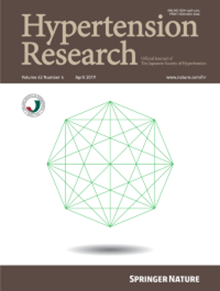大脑与高血压:大脑如何调节血压以及如何受到血压的影响。
IF 4.3
2区 医学
Q1 PERIPHERAL VASCULAR DISEASE
引用次数: 0
摘要
在血压(BP)与大脑的关系中,大脑扮演着多种角色:它是血压调节的控制中心、高血压的靶器官以及认知功能的重要组成部分。这篇微型综述介绍了《高血压研究》(Hypertension Research)和其他期刊有关 "大脑与高血压 "的最新研究成果。大脑中血管紧张素 II 1 型受体(AT1R)信号通路的激活会引起交感兴奋和高血压。AT1R相关蛋白和β-arrestin促进AT1R内化并抑制AT1R信号传导,在血压调节中具有脑特异性作用。大脑接收来自心脏和肾脏等外周系统的各种输入,并控制中枢交感神经的流出。参与增强心脏交感传入反射的大脑机制以及肾脏去神经化的有益作用已得到证实。高血压对大脑的危害包括中风,脑小血管疾病(SVD)导致中风风险和大脑变化。性别差异和高血压发病年龄会影响这些结果。高盐摄入会加剧高血压和中风风险,这与交感兴奋等中枢机制有关。高血压严重影响认知功能,与脑部 SVD 和认知能力下降有关。直立性血压调节异常也是痴呆症的早期风险标志。改善高血压患者的血压控制可大大降低中风和认知能力下降以及心血管疾病的风险,提高大脑的整体健康水平和生活质量。进一步了解大脑在血压调节和高血压发病机制中的作用,将有助于开发新型高血压治疗和预防策略。本文章由计算机程序翻译,如有差异,请以英文原文为准。

The brain and hypertension: how the brain regulates and suffers from blood pressure
The brain plays several roles in the relationship between blood pressure (BP) and the brain: it acts as the control center for BP regulation, a target organ in hypertension, and a crucial component for cognitive function. This mini-review introduces recent findings on “brain and hypertension” from Hypertension Research and other journals. Activation of the angiotensin II type 1 receptor (AT1R) signaling pathway in the brain causes sympathoexcitation and hypertension. AT1R-associated protein and β-arrestin promote AT1R internalization and suppress AT1R signaling, with brain-specific roles in BP regulation. The brain receives various inputs from the peripheral system, including the heart and kidneys, and controls central sympathetic outflow. The brain mechanism involved in the enhanced cardiac sympathetic afferent reflex and the beneficial effects of renal denervation have been demonstrated. The brain’s vulnerability in hypertension includes stroke, with cerebral small vessel disease (SVD) contributing to stroke risk and brain changes. Sex differences and the age of hypertension onset influence these outcomes. High salt intake exacerbates hypertension and stroke risk, with central mechanisms like sympathoexcitation implicated. Hypertension significantly impacts cognitive function, linking to cerebral SVD and cognitive decline. Orthostatic BP regulation abnormalities also emerge as early risk markers for dementia. Improved BP control in hypertensive individuals can significantly reduce the risk of stroke and cognitive decline, as well as cardiovascular disease, enhancing overall brain health and quality of life. Further understanding the brain’s role in BP regulation and the pathogenesis of hypertension will facilitate the development of novel hypertension treatments and prevention strategies.
求助全文
通过发布文献求助,成功后即可免费获取论文全文。
去求助
来源期刊

Hypertension Research
医学-外周血管病
CiteScore
7.40
自引率
16.70%
发文量
249
审稿时长
3-8 weeks
期刊介绍:
Hypertension Research is the official publication of the Japanese Society of Hypertension. The journal publishes papers reporting original clinical and experimental research that contribute to the advancement of knowledge in the field of hypertension and related cardiovascular diseases. The journal publishes Review Articles, Articles, Correspondence and Comments.
 求助内容:
求助内容: 应助结果提醒方式:
应助结果提醒方式:


